
Overbrook is an historic neighborhood that is located in the Commonwealth of Pennsylvania, United States. It is situated northwest of West Philadelphia, Philadelphia.

Massachusetts Avenue is a major diagonal transverse road in Washington, D.C., and the Massachusetts Avenue Historic District is a historic district that includes part of it.
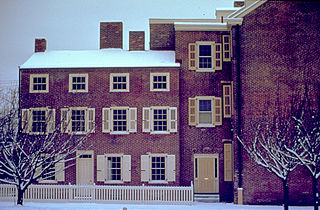
The Edgar Allan Poe National Historic Site is a preserved home once rented by American author Edgar Allan Poe, located at 532 N. 7th Street, in the Spring Garden neighborhood of Philadelphia, Pennsylvania. Though Poe lived in many houses over several years in Philadelphia, it is the only one which still survives. It was designated a National Historic Landmark in 1962.

Joseph Peter Lesley was an American geologist.

The Thomas Eakins House is a historic house at 1727-29 Mount Vernon Street in the Spring Garden section of Philadelphia, Pennsylvania, US. Built about 1854, it was for most of his life the home of Thomas Eakins (1844-1916), one of the most influential American artist of the late 19th century. It was designated a National Historic Landmark in 1965, and is now home to a local artist cooperative.

Grumblethorpe, in Germantown, Philadelphia, Pennsylvania, was the home of the Wister family, who lived there for over 160 years. It was built in 1744 as a summer residence, but it became the family's year-round residence in 1793. It is a museum, part of the Colonial Germantown Historic District.
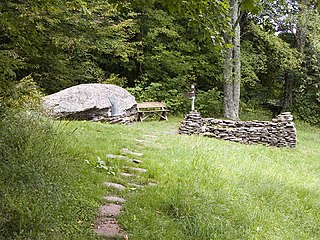
Woodchuck Lodge is a historic house on Burroughs Memorial Road in a remote part of the western Catskills in Roxbury, New York. Built in the mid-19th century, it was the last home of naturalist and writer John Burroughs (1837-1921) from 1908, and is the place of his burial. The property is now managed by the state of New York as the John Burroughs Memorial State Historic Site, and the house is open for tours on weekends between May and October. The property is a National Historic Landmark, designated in 1962 for its association with Burroughs, one of the most important nature writers of the late 19th and early 20th centuries.

Waynesborough, also known as the Gen. Anthony Wayne House, is a historic house museum at 2049 Waynesborough Road in Easttown Township, Chester County, Pennsylvania. Built in 1724 and repeatedly enlarged, it was for many years the home of American Revolutionary War general Anthony Wayne (1745–1796). A National Historic Landmark, it is now a museum operated by the Philadelphia Society for the Preservation of Landmarks, offering tours and event rentals.

The John Coltrane House is a historic house at 1511 North 33rd Street in Philadelphia, Pennsylvania, USA. A National Historic Landmark, it was the home of American saxophonist and jazz pioneer John Coltrane from 1952 until 1958. On his death in 1967 the house passed to his cousin, who sold it in 2004. Efforts for restoration and reuse as a jazz venue are struggling. In 2022, two of Coltrane's sons filed a lawsuit contesting the ownership of the home.
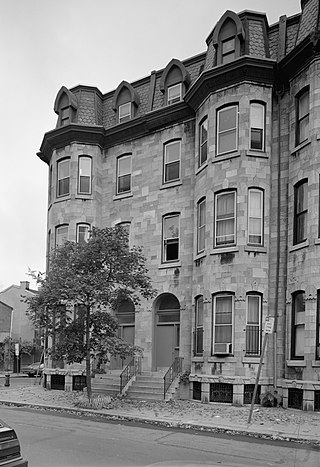
The Edward Drinker Cope House is a historic house located at 2100–2102 Pine Street in Center City Philadelphia, Pennsylvania. Built in 1880, it was a longtime home of Edward Drinker Cope (1840–1897), a prolific geologist and paleontologist and noted herpetologist who was one of the leading natural scientists of the 19th century United States. It was declared a National Historic Landmark in 1975.

The Hill–Physick–Keith House, also known as the Hill–Keith–Physick House, the Hill–Physick House, or simply the Physick House, is a historic house museum located at 321 S. 4th Street in the Society Hill neighborhood of Philadelphia, Pennsylvania, USA. Built 1786, it was the home of Philip Syng Physick (1768–1837), who has been called "the father of American surgery". The house was declared a National Historic Landmark in 1976. It is now owned and operated by the Philadelphia Society for the Preservation of Landmarks as a house museum.

The Reynolds-Morris House is an historic house which is located at 225 South 8th Street in the Washington Square West neighborhood of Philadelphia, Pennsylvania. Built between 1786 and 1787 by John and William Reynolds, it is a well-preserved example of a Philadelphia Georgian townhouse.

The Thomas Sully Residence is a historic rowhouse at 530 Spruce Street in Philadelphia, Pennsylvania, USA. It was briefly (1828–29) a home of painter Thomas Sully (1783-1872), who lived in Philadelphia for the last 64 years of his life.
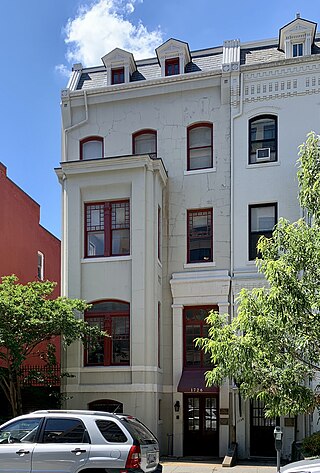
The Elliott Coues House is a historic house at 1726 N Street NW, in the Dupont Circle neighborhood of Washington, D.C. Built about 1880, it was the home of 19th-century historian and ornithologist Elliott Coues (1842–99) from about 1887 until his death. Coues helped found the American Ornithologists' Union in 1883 and edited about 15 volumes of journals, memoirs, and diaries by famous Western explorers and fur traders. The house was declared a National Historic Landmark in 1975.

The David White House is a historic house at 1459 Girard Street NW in Washington, D.C. A National Historic Landmark, it was the home of geologist David White (1862–1935) from 1910 to 1925. White had a longtime association with the United States Geological Survey (USGS), and performed groundbreaking research on peat and petroleum geology.
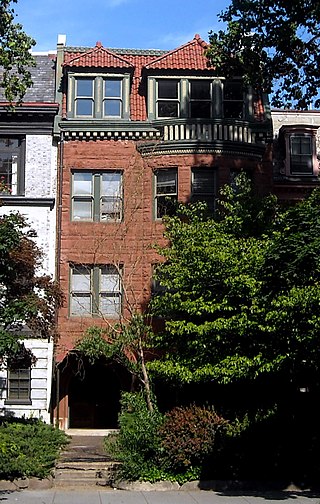
The Robert Simpson Woodward House is a former residence located at 1513 16th Street, NW in the Dupont Circle neighborhood of Washington, D.C. From 1904 until 1914, it was a home of geologist Robert Simpson Woodward (1849–1924), the first president of the Carnegie Institution and a highly regarded scientist and science administrator. The building currently serves as the Capital Research Center headquarters. It was declared a National Historic Landmark in 1976 and designated a contributing property to the Sixteenth Street Historic District in 1978.

The Nathan and Mary (Polly) Johnson properties are a National Historic Landmark at 17–19 and 21 Seventh Street in New Bedford, Massachusetts. Originally the building consisted of two structures, one dating to the 1820s and an 1857 house joined with the older one shortly after construction. They have since been restored and now house the New Bedford Historical Society. The two properties are significant for their association with leading members of the abolitionist movement in Massachusetts, and as the only surviving residence in New Bedford of Frederick Douglass. Nathan and Polly Johnson were free African-Americans who are known to have sheltered escaped slaves using the Underground Railroad from 1822 on. Both were also successful in local business; Nathan as a caterer and Polly as a confectioner.
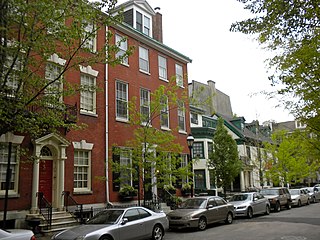
Clinton Street Historic District is a national historic district located in the Washington Square West neighborhood of Philadelphia, Pennsylvania. It includes 71 brick rowhouses built between 1835 and 1850. They are between 3 1/2- and 4-stories and consist of the typical Philadelphia rowhouse plan with front building, piazza, and back building. It was a fashionable residential section in the 19th century and home to such notable figures as architect Addison Hutton (1834–1916), Rt. Rev. William Bacon Stevens (1815-1887), and Agnes Repplier (1855-1950). Located in the district and separately listed is the J. Peter Lesley House at 1008 Clinton Street.
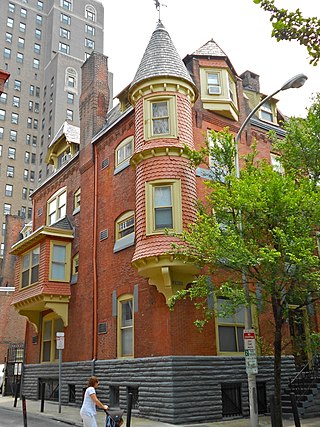
Hockley Row – also known as Evans Row or Victoria House – is a set of four architecturally significant rowhouses, which are located in the Rittenhouse Square West neighborhood of Philadelphia, Pennsylvania.

Girard Avenue is a major commercial and residential street in Philadelphia, Pennsylvania. For most of its length it runs east–west, but at Frankford Avenue it makes a 135-degree turn north. Parts of the road are signed as U.S. Route 13 and U.S. Route 30.

























